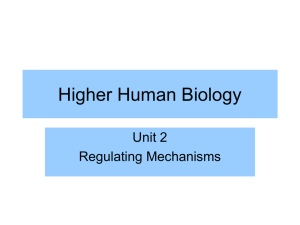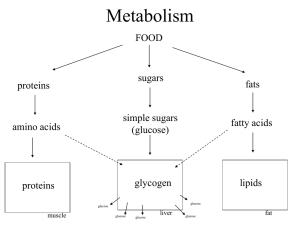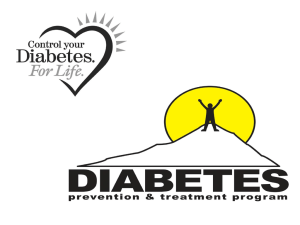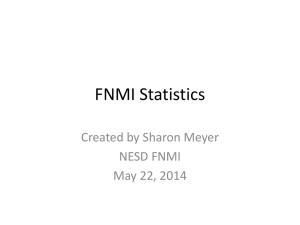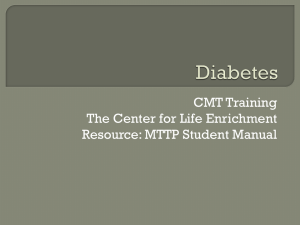All about Diabetes - World of Teaching
advertisement
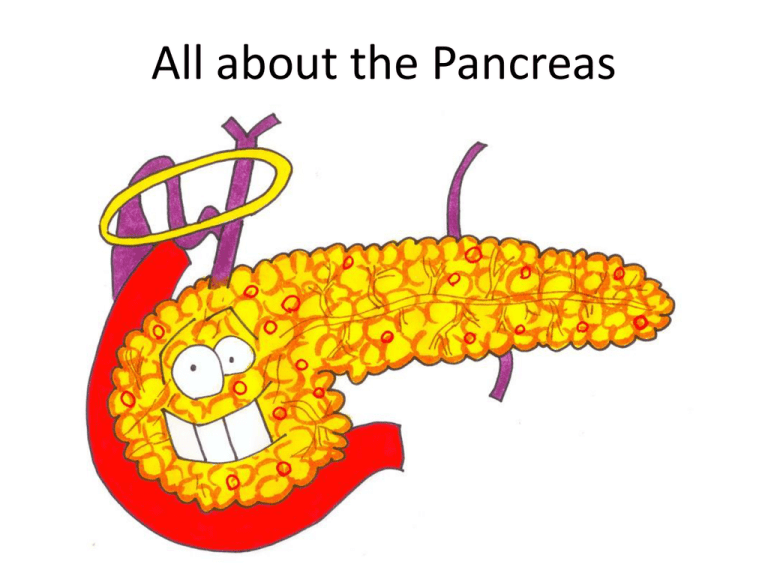
All about the Pancreas A. You start by eating a meal containing carbohydrates. B. These carbohydrates are turned into glucose. The glucose is absorbed by the stomach and intestines and goes into the blood. C. Now, your blood has a high glucose level. Your blood has the glucose but who needs the glucose???? The cells!! Cells use glucose to make energy called ATP. D. The cells can only take in glucose if the pancreas secretes insulin (a hormone.) E. Insulin attaches to muscle, liver and fat cells and lets them take in glucose. Think of it like insulin knocking on the door of the cells to let glucose in. F. Then, the glucose level in the blood goes down BACK TO NORMAL. HOMEOSTASIS!!!!. Now, the pancreas stops secreting insulin Insulin binds to a receptor on the surface of a cell. The sugar goes into the cells and is used for CELLULAR RESPIRATION Hyperglycemia: HIGH BLOOD SUGAR LEVELS What are some symptoms of hyperglycemia? • very thirsty • frequent urination •Dry skin •Blurred vision • hungry •Kidney problems (they have to filter all the glucose out of your body!!!) What if your blood doesn’t have enough sugar? • Also called HYPOGLYCEMIA: NOT ENOUGH BLOOD SUGAR • The islets of Langerhans (in your pancreas) would make the opposite hormone of insulin. • Alpha cells would make Glucagon!!!! This makes the liver release stored glucose into your blood! • So to review, your pancreas has areas called the islets of Langerhans. Inside them, the alpha cells make glucagon and the beta cells make insulin • HOMEOSTASIS!!!!! Symptoms of hypoglycemia • Confusion/abnormal behavior • Blurred vision • Pass out • Sweating • Nervous • Shakiness • Heart palpitations (not normal heartbeat) What if your pancreas makes less insulin, no insulin OR cells just don’t care about insulin anymore (resistance) ? Diabetes 당뇨병 Diabetes • Type I (~10%): pancreas cells (beta cells of the islets of Langerhans) that make insulin are lost. Most cases are in children so this was called “juvenille diabetes” • Type II (~90%): the cells of the body stop responding to insulin (insulin resistance) or can lose insulin production Diabetes Type I • Around 5-10% of people in the U.S.A. with diabetes. • Develops in people at a very young age (under age 20). • Not caused by diet (immune system attacks body) • Their pancreas damaged and they cant make insulin islet cells of the pancreas Diabetes Type II • The patient can make insulin, but the cells are resistant (they don’t respond or “care”) Diabetes Type II: This is called Diabetes Type II. It usually affects adults. This type of diabetes is 9095% of all diabetes cases in the U.S.A. Cause: genetics and LIFESTYLE Diabetes Type II • Why would your pancreas make less insulin or your cells (e.g. muscles) not care about insulin anymore (insulin resistance)? • This usually develops with people who have a horrible diet with too much sugar. If you eat so much sugar every day, your pancreas “gets tired” of making so much. (less insulin) • Also, like most drugs, the cells that need insulin become resistant. The cells no longer “hear insulin knocking on the door” to let glucose in. • Either way, the glucose stays in the blood and NOT THE CELLS THAT NEED IT. Diabetes creating lifestyle October, 2010 Obesity:비만 “…..almost no obesity” “…expect no one in Korea would have diabetes” “…..weight alone doesn’t cause diabetes” “…..Korea has the same incidence (rate) of diabetes” “…..is work, not obesity the cause?” “…..Miracle of the Han river……work, work, work, work….” “…..workers in South Korea have longest working hours…” OECD: The Organization for Economic Cooperation and Development [group of 34 democracies] “…..a thin country has nearly the same rate of diabetes as the U.S.A…” “…..9.1% of Korean adults have diabetes (2005)…” “…..change from vegetarian to eating junk food, meat and dairy..…” “…..problems include stress and little exercise…” “…..Korean men relieve (lose) stress by drinking, not with exercise…” “…..diabetes is a lifestyle disease….what we consume (eat), exercise, how we deal with stress…”







